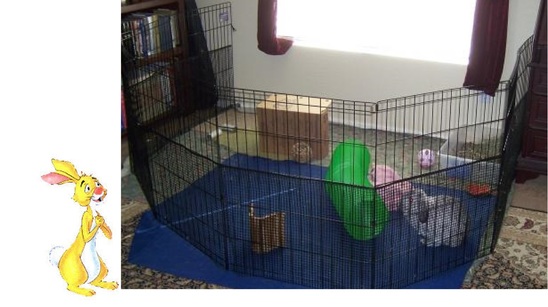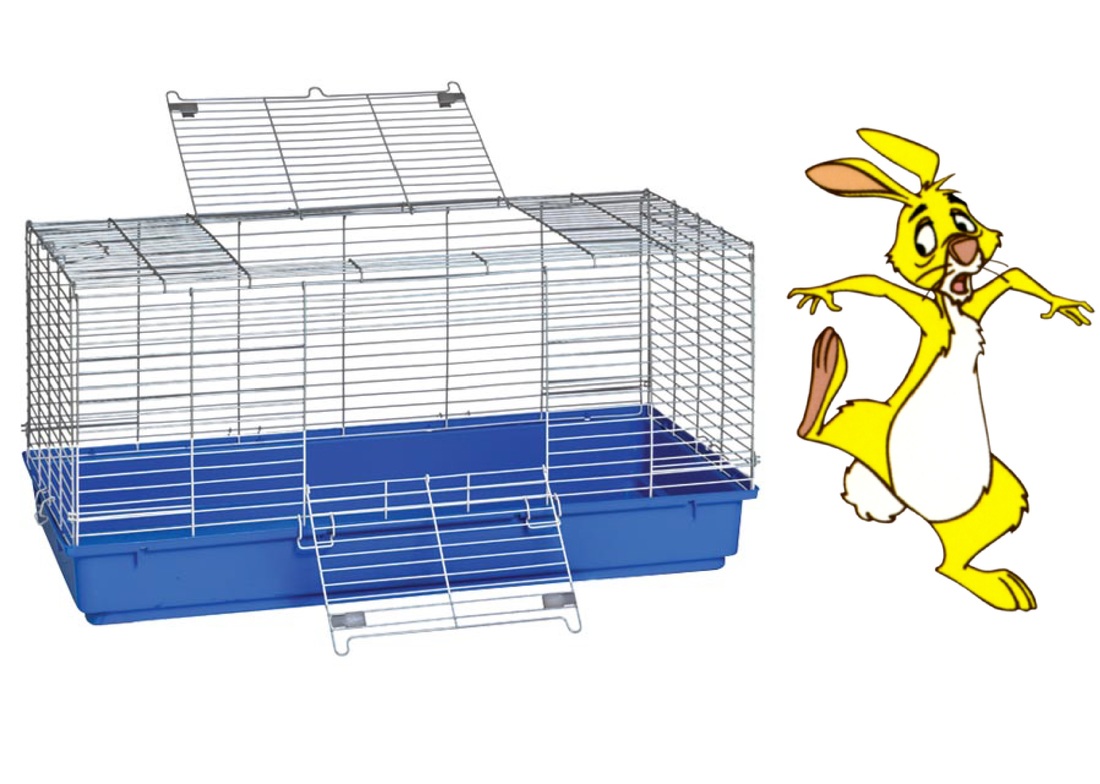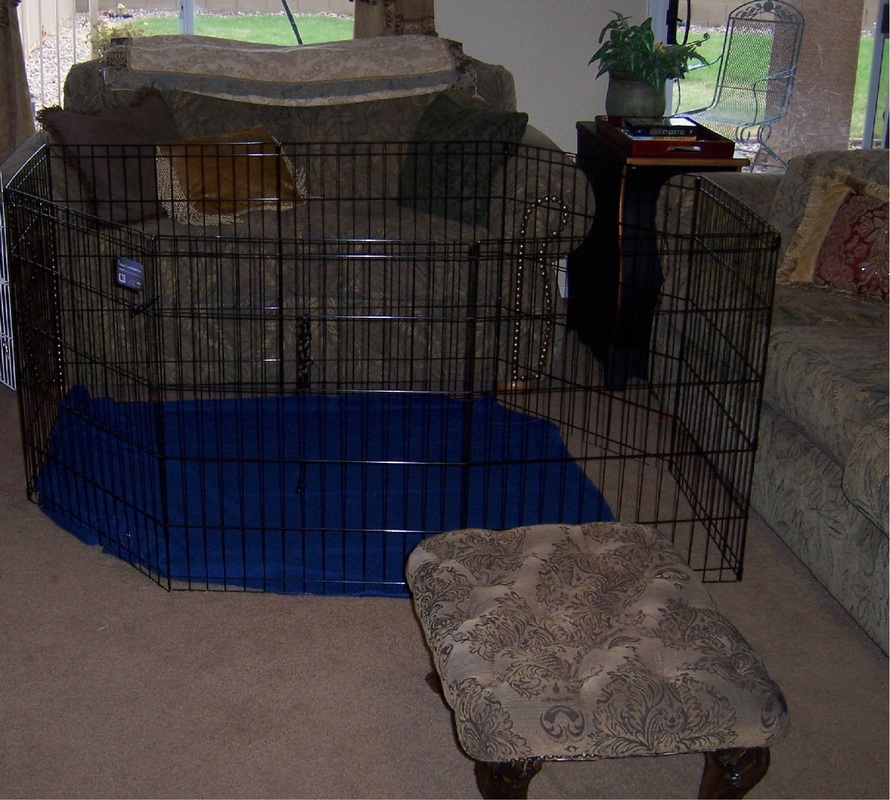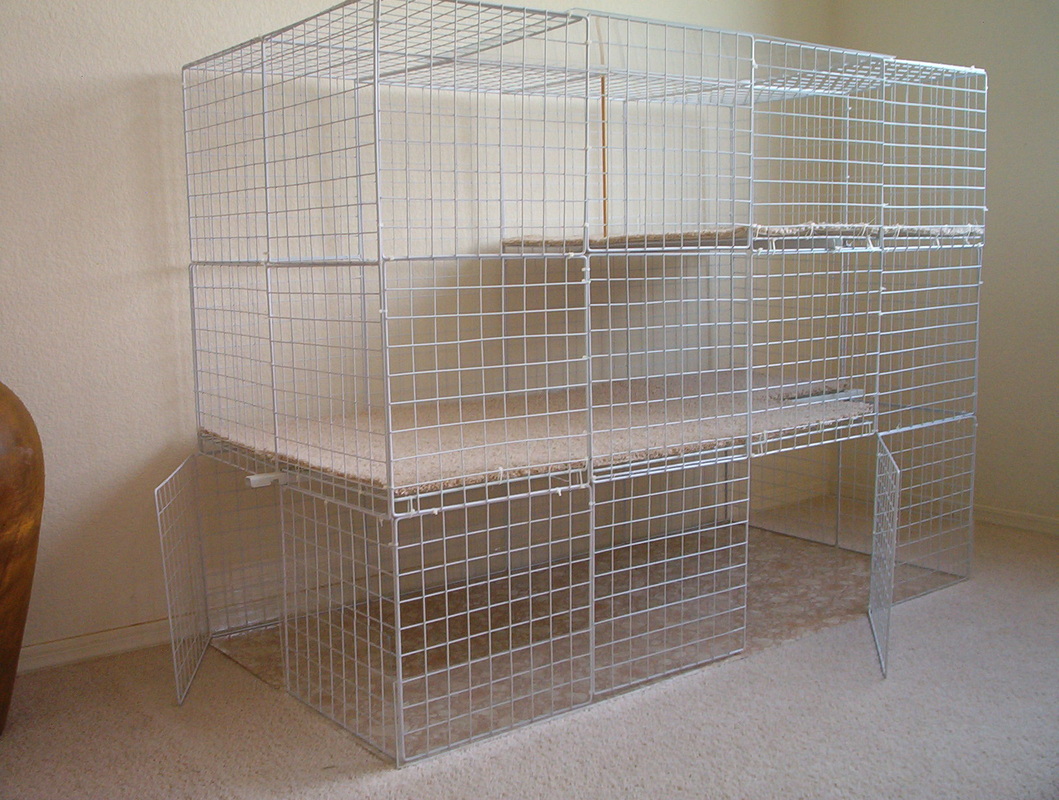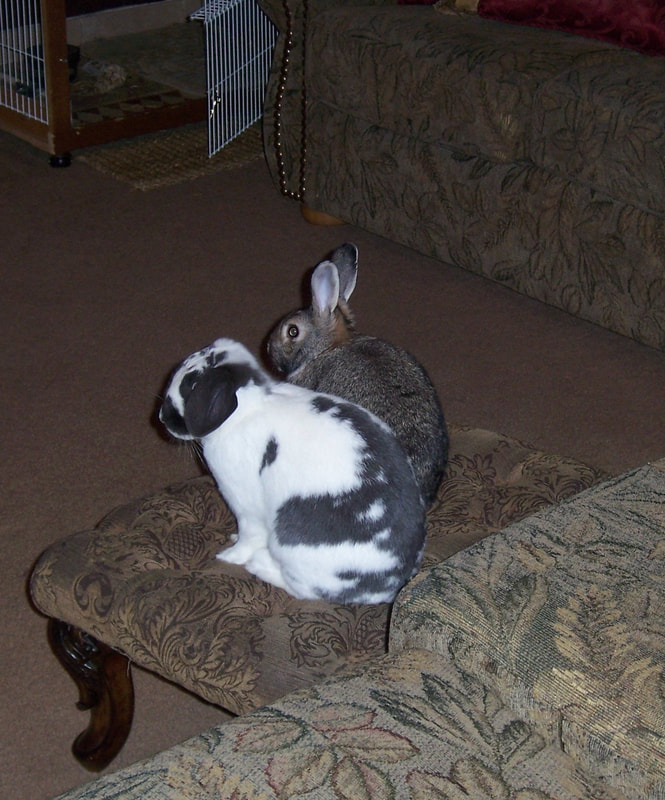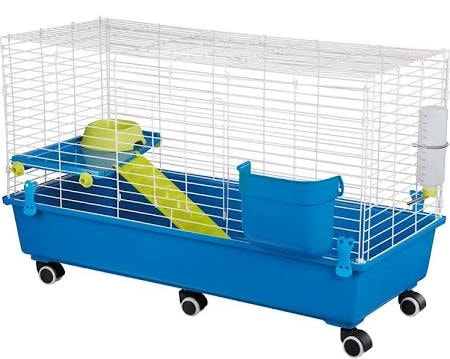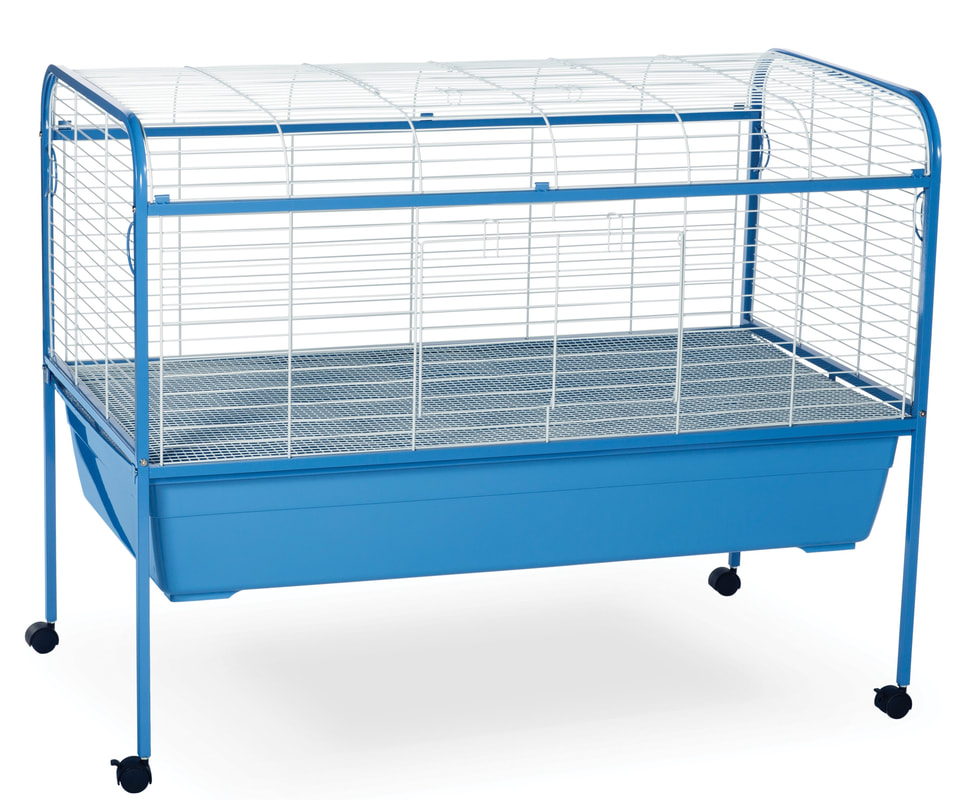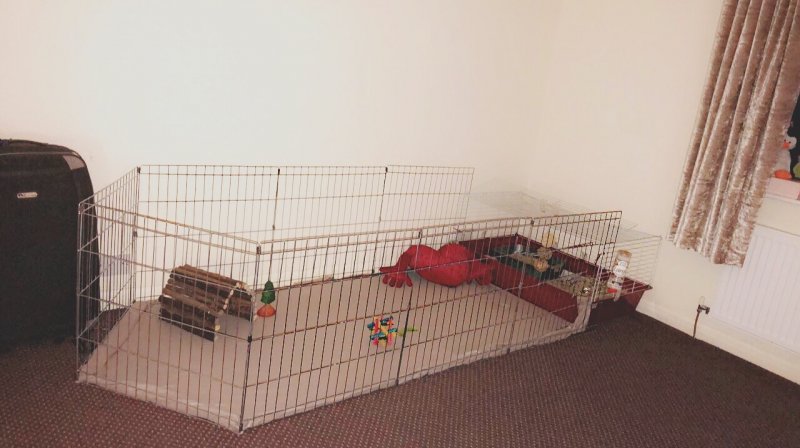[ Tablet users, try the "web" version by clicking on "web" at the bottom of this page for a better, user-friendly format. ]
Housing Options
The cage is the first thing that comes to mind for housing rabbits indoors. And usually the picture envisioned is a wire cage that one person could easily lift and carry. This picture is one that needs to be erased from our minds. We need to think larger, much larger, than that original picture.
How much time out of cage will your rabbit get?
How often bunny will be getting exercise is a major factor in determining the appropriate size for the cage.
- little time out?
A rabbit who is rarely allowed out will need a huge cage to accommodate his exercise needs. If one or two hours is the most bunny will get out each day, this would be considered a 'little time out.' In such a case, a minimum of about 30 square feet of space should be incorporated into his permanent living space. If this sounds unreasonable, don't despair. This is more easily done than one might imagine.
|
- lots of time out?
For rabbits who are allowed out all day or at least 5-6 hours each day, their enclosure can be somewhat smaller. NIC cubes and/or exercise pens can be used to make cages that may not meet the 30 square foot minimum but are still easily triple the size of those 'envisioned' cages. Don't go less than 9 - 12 square feet. Since bunny isn't confined all day, such a cage can suffice.
|
- (almost) always out?And for those lucky rabbits who are allowed to free roam 24/7, only a "home-base" cage is required. In such a scenario, cage size really doesn't matter because the rabbit is never confined in the cage. The door is always left open. This is one instance in which those smaller pet store cages can be used. For details on how to begin free roaming a rabbit check this page.
|
|
- how to provide 30 square feet or more
Remember, a rabbit needs regular, daily exercise for muscular, skeletal, and digestive health. Since rabbits keep their own schedules, they need large time blocks in order to get their needed exercise. Simply opening a cage door for an hour a day isn't going to be sufficient. It's very possible that the chosen hour may happen to be when bunny is napping or simply isn't interested in hopping about. If your schedule only allows for the occasional hour or two to open the cage door, then the option above may be for you. Exercise pens are great for creating those 30 square foot (or larger) cages. Some owners use a combination of NIC and x-pens, or an xl dog crate and an x-pen to make a roomy space for bunny. Even a small cage, used in combination with a large enough x-pen, can provide the minimum square footage. Just be sure the cage door is always left open to allow access to the surrounding pen. |
- cages for rabbits with lots of time out
Where in the home the cage will go will take careful thought. That area will need to be bunny-proofed to allow for exercise and be able to accommodate the cage. This decision will also help you determine what size/type cage can fit. NIC cages are multi-level, so they can provide more space on a smaller footprint than an x-pen cage. There are examples of each of these types of cages in the PHOTO GALLERY and other ideas at the site linked through the button tabs below. |
- allowing rabbits out of their enclosure
With a properly bunny-proofed area, many rabbit owners have resorted to simply leaving the cage door open 24/7. In such a case, the "cage" is merely serving as a "home base" for housing the litter box and food/water dishes, as well as providing a personal space. A "home base" cage doesn't need to be large since bunny is never confined in it. A free roaming rabbit doesn't have to have access to the entire home. For example, a family room, hallways and kitchen could be designated for the rabbits. An office and bedrooms could be off limits. Baby gates, NIC grids, x-pens or existing doors can all serve as barricades to limit range. |
Choosing the cage location in the home
When choosing the type or style of cage you will be using, it's a good idea to consider where you will be allowing bunny to exercise every day. The cage should be permanently kept in the same place as this exercise area. A logical location is where the family spends a lot of time. Family rooms can be ideal if this is commonly where people gather especially in the evenings when bunnies tend to be most active. Sometimes eat-in kitchens and/or dining areas can be used as well. Bear in mind that this area will need to be bunny proofed. Any adjoining off-limits areas or rooms will need to be blocked off. An isolated room or "bunny room" is not a good option unless it is regularly frequented by family members (which seems seldom to be the case). Rabbits like to be a part of the daily activity and see what is going on in their little world.
The cage ideally should be at floor level. Simply opening the cage door should allow bunny out, so it's best if the cage is on the floor. It's important that bunny can freely go in and out of the cage at will during that time. If this just isn't possible, then a step or two can be made to allow bunny easy access back to his cage.
The cage ideally should be at floor level. Simply opening the cage door should allow bunny out, so it's best if the cage is on the floor. It's important that bunny can freely go in and out of the cage at will during that time. If this just isn't possible, then a step or two can be made to allow bunny easy access back to his cage.
A word about cage flooringWhichever cage type or combination you decide upon, there will be multiple flooring options from which to choose. If your rabbit isn't fully litter trained, options may be temporarily limited to wipe-able or washable materials. Each of the options will ultimately depend upon your individual rabbit. Some flooring options will be chewed by some rabbits but not by others. So it will come down to trial and error to see what works with your bunny. Please keep this in mind when considering your options.
Variety is a good idea when it comes to flooring. Try to have at least two or three different types of flooring in your rabbit's cage. This allows your rabbit to have options. For all the lounging they do, it's nice for them to have choices for comfort. A soft bed or material may be nice for awhile, but if bunny gets warm, he may want to sprawl out on a single floor tile or other solid surface. The NIC cages, dog crates and x-pens can easily accommodate a few different floorings. Those small, purchased cages that come with a wire-bottom floor should have the wire-bottom removed (see note below). The plastic bottom of those cages can prove too slippery for a rabbit's furry paws so should be covered. Consider how edges of your flooring choices will be handled. Rolled linoleum, for instance, can make a good flooring but if the edges can be accessed, bunny is likely to chew them. The NIC cage shown above has linoleum on the bottom floor but the edges are tucked beyond the cage walls. This prevents bunny from being able to reach them. |
|
Note about wire-bottomed cages: Many rabbit sites will tell you that wire-bottom cages can lead to sore hocks. This does happen. However some rabbits have been known to get sore hocks that were kept exclusively on carpeted flooring [which is why variety is a good idea]. Rabbits have also been known to get their nail stuck in the wire and subsequently ripped off entirely. Wire-bottom cages were created just for the convenience of the owner -- particularly breeders who have many rabbits. The rabbit's comfort was not a consideration. For an indoor pet rabbit, there is no reason to have a wire-bottom cage. Such cages are no less work than using a litter box, are uncomfortable for bunny and are unnecessary. A rabbit that is, or is going to be, litter trained has no need for wire-bottom flooring.
Once you've decided what kind of cage you will have and where it will be in your home,
the next step will be getting it all set up.
the next step will be getting it all set up.
What's wrong with these cages?
At first glance, these cages may seem like good options. But let's take a closer look.
|
The floor of this cage is solid plastic. Rabbits do not have pads on their paws - just fur. They cannot get any grip on the plastic (this goes for the useless ramp and the tiny shelf too). Leg injury is possible as their paws slip on the surface.
Hay rack is far too small. The bowl on the shelf takes up too much of the shelf - no room for lounging. Add a water bowl and bunny could not even fit on the shelf. |
Door of cage: The doors of both cages open downward like a ramp instead of sideways like a normal door. That means that bunny paws can become trapped in the ramp whenever bunnies are allowed out for exercise.
Size of cage: While these cages may be larger than other pet store cages, they are still too small for an adult rabbit. An adult rabbit would barely be able to take one hop. Rabbits need more space to move. The size also doesn't allow room for a decent size litter box. In essence, the entire cage must become a litter box. One would never think to confine a cat in such a cage. It is just as inappropriate for a rabbit. |
The floor of this cage is wire bottom. Wire bottom cages can cause sore hocks as explained above. They also pose risk for nails getting caught and ripped out.
With the cage raised off the floor with the stand, bunny is prevented from being able to hop in and out during exercise time. |
How to make them usable...
If you happen to have a cage similar to either of these and cannot return it, there are ways to make it somewhat usable.
Place the cage against a wall and shape an x-pen into a 'U' around the cage. (See the photo below.) Remove the door of the cage (or the whole front panel as in photo) so that bunny's permanent space includes the exercise pen area. In this way, the original cage becomes a resting area for bunny within his larger, permanent housing. He is free to come and go out of the smaller cage at will.
Alternatively, remove the entire wire top of the cage (and wire bottom, if it has one) and use the base as a large litter box. If it is too large for that, then fleece or other soft bedding can be placed inside to make a lounging area.
Place the cage against a wall and shape an x-pen into a 'U' around the cage. (See the photo below.) Remove the door of the cage (or the whole front panel as in photo) so that bunny's permanent space includes the exercise pen area. In this way, the original cage becomes a resting area for bunny within his larger, permanent housing. He is free to come and go out of the smaller cage at will.
Alternatively, remove the entire wire top of the cage (and wire bottom, if it has one) and use the base as a large litter box. If it is too large for that, then fleece or other soft bedding can be placed inside to make a lounging area.
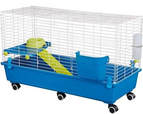
To make this cage more usable within an exercise pen, remove the water bottle (instead use a bowl either within the cage or elsewhere in the pen), remove the ramp (not needed and too slippery), remove hay rack (see other options for providing hay), remove the door.
|
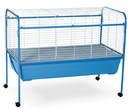
To make this cage more usable within an exercise pen, remove the wire bottom, remove the stand so that the cage is resting directly on the floor. Once the door is also removed, bunny will be able to hop in and out into the area that has been created by the exercise pen.
|
The set-up below shows how the addition of an exercise pen can make these types of cages usable.
|
Using a little creativity is always an option. Here I used an old kitchen oven cabinet and some spare tile to make a cage that's left open about 15 hours per day. Since I only had to purchase a few items, this cage cost me about $25 total.
|
